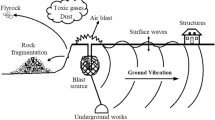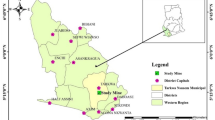Abstract
Ground vibrations induced by blasting are one of the fundamental problems in the mining industry and may cause severe damage to structures and plants nearby. Therefore, a vibration control study plays an important role in the minimization of environmental effects of blasting in mines. In this paper, an attempt has been made to predict the peak particle velocity using support vector machine (SVM) by taking into consideration of maximum charge per delay and distance between blast face to monitoring point. To investigate the suitability of this approach, the predictions by SVM have been compared with conventional vibration predictor equations. Coefficient of determination (CoD) and mean absolute error were taken as a performance measure.









Similar content being viewed by others
References
Ambraseys NR, Hendron AJ (1968) Dynamic behaviour of rock masses. Rock mechanics in engineering. Practices, Wiley, London, pp 203–207
Bureau of Indian Standard (1973) Criteria for safety and design of structures subjected to underground blast. ISI Bulletin, IS-6922
Cristianini N, Shawe-Taylor NJ (2000) An introduction to support vector machines. Cambridge University Press, Cambridge
Duvall WI, Fogleson DE (1962) Review of criteria for estimating damage to residences from blasting vibration, USBM-I, 5968
Duvall WI, Petkof B (1959) Spherical propagation of explosion of generated strain pulses in rocks, USBM, RI 5483, pp 21–22
Feng XT, Zhao H, Li S (2004) Modeling non-linear displacement time series of geo-materials using evolutionary support vector machines. Int J Rock Mech Min Sci 41(7):1087–1107
ISRM (1992) Suggested method for blast vibration monitoring. Int J Rock Mech Min Sci and Geomech Abstr 29:145–146
John CP (1998) Sequential minimal optimization: a fast algorithm for training support vector machines. Technical report, MSR-TR-98-14
Khandelwal M, Singh TN (2006) Prediction of blast induced ground vibrations and frequency in opencast mine—a neural network approach. J Sound Vib 289:711–725
Khandelwal M, Singh TN (2007) Evaluation of blast induced ground vibration predictors. Soil Dyn Earthq Eng 27:116–125
Khandelwal M, Singh TN (2009) Prediction of blast induced ground vibration using artificial neural network. Int J Rock Mech Min Sci 46:1214–1222
Khandelwal M (2010) Evaluation and prediction of blast induced ground vibration using support vector machine. Int J Rock Mech Min Sci 47(3):509–516
Langefors U, Kihlstrom B (1963) The modern technique of rock blasting. Wiley, New York
Liu KY, Qiao CS, Tian SF (2004) Design of tunnel shotcrete-bolting support based on a support vector machine approach. Int J Rock Mech Min Sci 41(3):510–511
Muller KR, Smola JA, Scholkopf B (1997) Prediction time series with support vector machines. In: Proceedings of international conference on artificial neural networks, Switzerland, Lausanne, pp 999–1004
Pal Roy P (1993) Putting ground vibration predictors into practice. Colliery Guardian 241:63–67
Schmidt M (1996) Identifying speaker with support vector networks. In: Interface ‘96 Proceedings, Sydney
Scholkopf B, Burges C, Vapnik V (1995) Extracting support data for a given task. In: Proceedings of the first international conference on knowledge discovery and data mining. AAAI Press, Menlo Park
Siskind DE, Stagg MS, Kopp JW, Dowding CH (1980) Structure response and damage produced by ground vibration from surface mine blasting. US Bureau of Mines, RI, 8507, p 74
Vapnik VN (1998) Statistical learning theory. Wiley, New York
Witten IH, Frank E (2005) Data mining: practical machine learning tools and techniques, 2nd edn. Morgan Kaufmann, San Francisco
Author information
Authors and Affiliations
Corresponding author
Rights and permissions
About this article
Cite this article
Khandelwal, M. Blast-induced ground vibration prediction using support vector machine. Engineering with Computers 27, 193–200 (2011). https://doi.org/10.1007/s00366-010-0190-x
Received:
Accepted:
Published:
Issue Date:
DOI: https://doi.org/10.1007/s00366-010-0190-x




